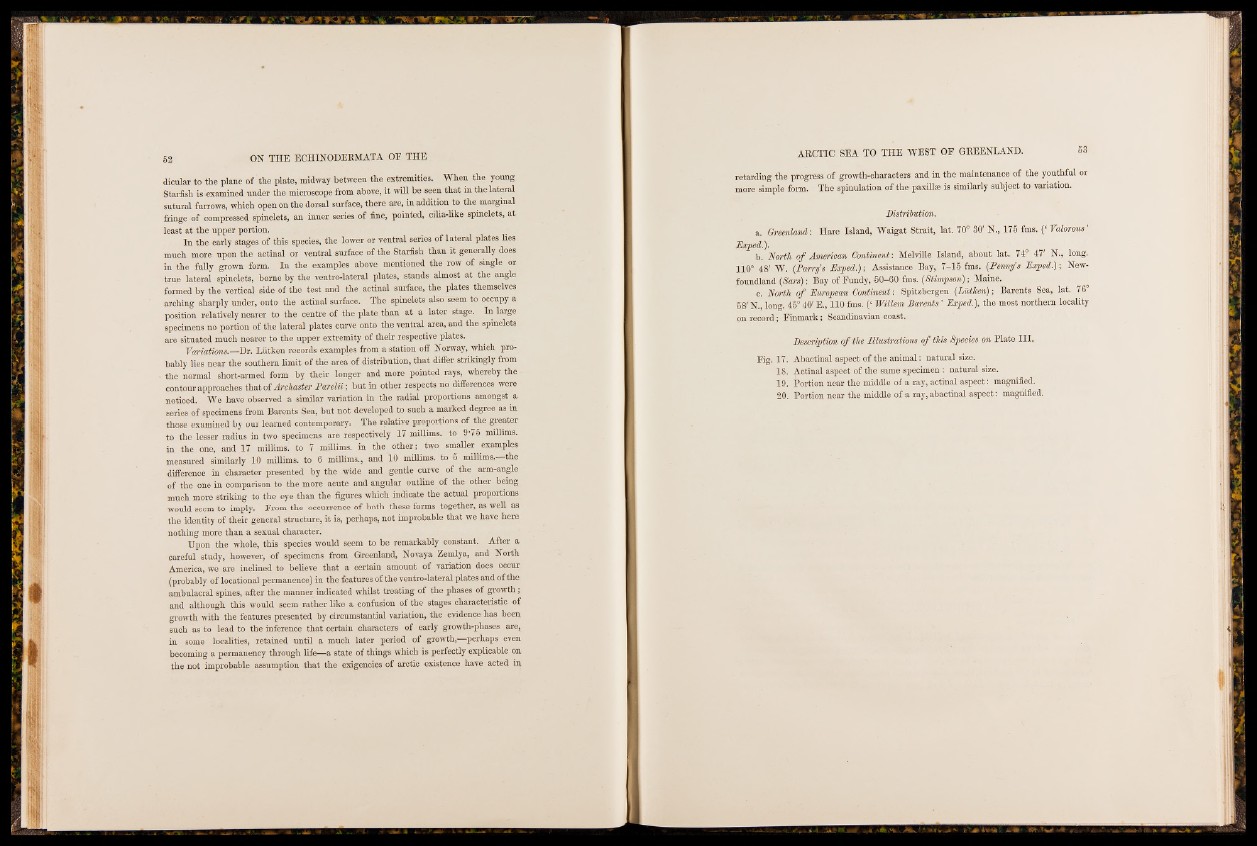
dicular to the plane of the plate, midway between the extremities. When the young
Starfish is examined under the microscope from above, it will be seen that in the lateral
sutural furrows, which open on the dorsal surface, there are, in addition to the marginal
fringe of compressed spinelets, an inner series of fine, pointed, cilia-like spinelets, at
least at the upper portion.
In the early stages of this species, the lower or ventral series of lateral plates lies
much more upon the actinal or ventral surface of the Starfish than it generally does
in the fully grown form. In the examples above mentioned the row of single or
true lateral spinelets, borne by the ventro-lateral plates, stands almost at the angle
formed by the vertical side of the test and the actinal surface, the plates themselves
arching sharply under, onto the actinal surface. The spinelets also seem to occupy a
position relatively nearer to the centre of the plate than at a later stage. In large
specimens no portion of the lateral plates curve onto the ventral area, and the spinelets
are situated much nearer to the upper extremity of their respective plates.
Variations.—Dr. Lutken records examples from a station off Norway, which probably
lies near the southern limit of the area of distribution, that differ strikingly from
the normal short-armed form by their longer and more pointed rays, whereby the
contour approaches that of Archaster Parelii; but in other respects no differences were
noticed. We have observed a similar variation in the radial proportions amongst a
series of specimens from Barents Sea, but not developed to such a marked degree as in
those examined by our learned contemporary. The relative proportions of the greater
to the lesser radius in two specimens are respectively 17 millims. to 9*75 millims.
in the one, and 17 millims: to 7 millims. in the other; two smaller examples
measured similarly 10 millims. to 6 millims., and 10 millims. to 5 millims.—the
difference in character presented by the wide and gentle curve of the arm-angle
of the one in comparison to the more acute and angular outline of the other being
much more striking to the eye than the figures which indicate the actual proportions
would seem to imply, From the occurrence of both these forms together, as well as
the identity of their general structure, it is, perhaps, not improbable that we have here
nothing more than a sexual character.
Upon the whole, this species would seem to be remarkably constant. After a
careful study, however, of specimens from Greenland, Novaya Zemlya, and North
America, we are inclined to believe that a certain amount of variation does occur
(probably of locational permanence) in the features of the ventro-lateral plates and of the
ambulacral spines, after the manner indicated whilst treating of the phases of growth;
and although this would seem rather like a confusion of the stages characteristic of
growth with the features presented by circumstantial variation, the evidence has been
such as to lead to the inference that certain characters of early growth-phases are,
in some localities, retained until a much later period of growth, perhaps even
becoming a permanency through life—a state of things which is perfectly explicable on
the not improbable assumption that the exigencies of arctic existence have acted in
retarding the progress of growth-characters and in the maintenance of the youthful or
more simple form. The spinulation of the paxillee is similarly subject to variation.
Distribution,
a. Greenland: Hare Island, Waigat Strait, lat. 70° 30' N., 175 fms. (‘ Valorous'
Doped.).
b. North o f American Continent: Melville Island, about lat. 74° 47' N., long.
110° 48' W. (Parry's Doped.); Assistance Bay, 7-15 fms. (Penny's Doped.); Newfoundland
(Sars); Bay of Fundy, 50-60 fms. (Stimpson); Maine.
c. North o f Dwropean Continent: Spitzbergen (Lutken); Barents Sea, lat. 76°
58' N., long. 45° 40' E., 110 fms. (‘ Willem Barents' Doped.), the most northern locality
on record; Finmark; Scandinavian coast.
Description o f the Illustrations o f this Species on Plate III,
Fig. 17. Abactinal aspect of the animal: natural size.
18. Actinal aspect of the same specimen : natural size.
19. Portion near the middle of a ray, actinal aspect: magnified.
20. Portion near the middle of a ray, abactinal aspect: magnified.